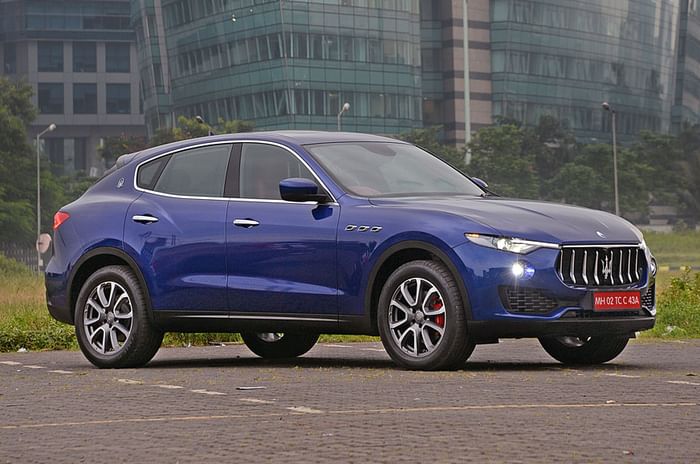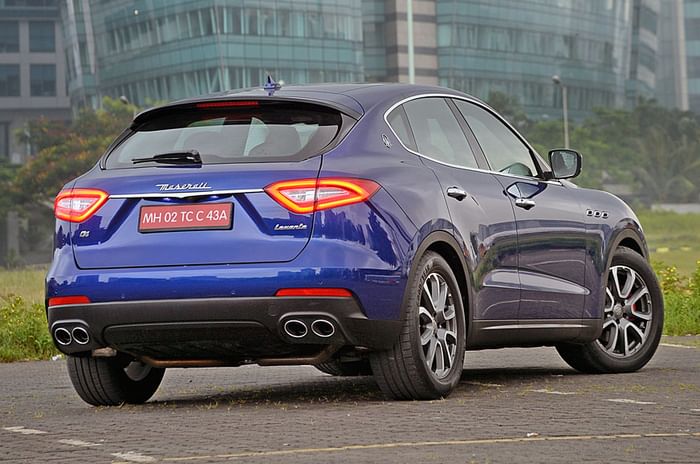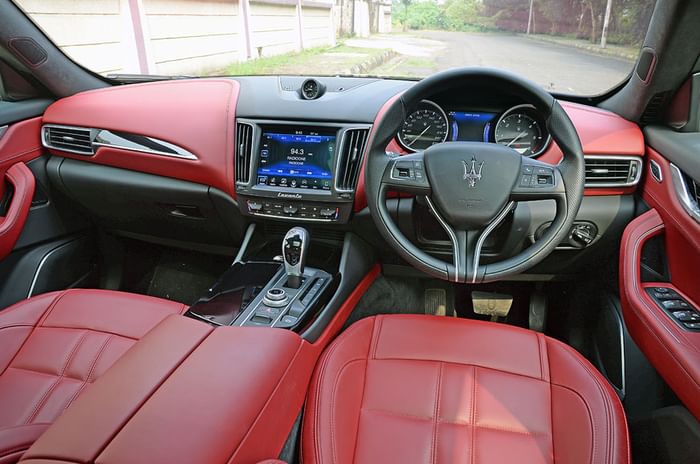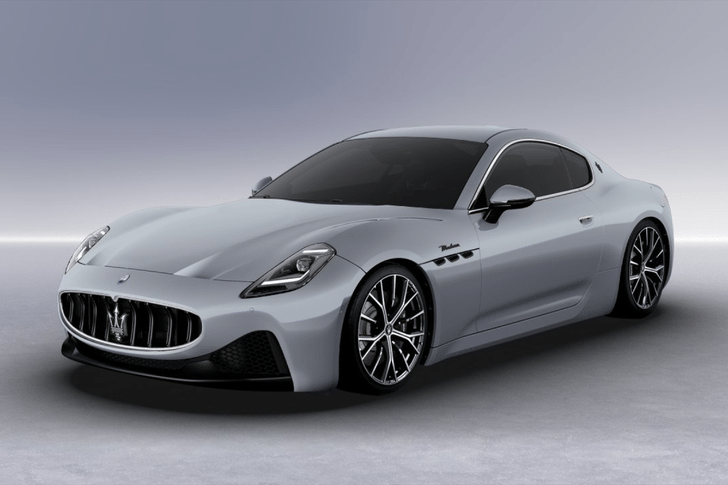As I glance down every once in a while to the touchscreen at the centre of the dashboard, I catch a quick glimpse of the plaque with the car’s name on it. Only out of the corner of my eye though, and for some reason, the first word my brain registers – again and again – is ‘Leviathan’. The plaque says ‘Levante’ of course, which is the name of a Mediterranean wind that can turn into a gale in an instant; go figure. But Leviathan is the sense I get from behind the wheel of this SUV, and I suspect that was, at some level, Maserati’s intention too.
For a five-seat SUV, this thing is enormous, especially its length, which is a few layers of paint thicker than five metres, an unusually large percentage of which is bonnet. It feels it from behind the wheel too, as I peer down that vast hood and try to get a feel for its extremities. I’ve got the snug, sporty driver’s seat almost in its highest position in order to achieve this, but taller folk might be able to lower it to a position that feels closer to a conventional Maserati – more sportscar-like. But I recall that, when I first got in, it was quite a climb up off the ground.
You see what I’m getting at here. They might call it ‘the Maserati of SUVs’, but on first acquaintance at least, the Levante feels like it hasn’t quite decided what it wants to be more of – Maserati or SUV. Have they got the mix just right?

First things first, whether you’re fan or not, this doesn’t look like what convention dictates an SUV to look like. When the world bore witness to the stunning Maserati Alfieri concept car back in 2014, who would have thought the first car to draw inspiration from it would be a massive 4x4. It is the antithesis of a Range Rover – it’s not tall or bulky, or upright or square-edged. The long bonnet, curved roofline, hatchback-like sloped tailgate, voluptuous rear haunches, and myriad cuts and creases make it look athletic, like a shooting brake – think Ferrari GTC4 Lusso, but larger and more pumped up. So, here too, it’s a bit confused. It’s certainly got the outright mass to be an SUV, it rides – even on its air suspension’s medium setting – high off the ground, it’s got huge wheels and chunky tyres, and a monstrous grille at the front. But the proportions just don’t fit. It looks like a cat ready to pounce, but from off the top of a skateboard. Love it or hate it, there’s nothing quite like the seeing the gobsmacked look on other motorists’ faces as they eyeball this rare, unusual and imposing vehicle.
MASTER CLASS
Once you’re ensconced in the cabin of the Levante, it’s certainly more Maserati than 4x4. Red leather would look outlandish in most SUVs, but here, somehow, it just works. And it is soft, supple leather too, Neptune’s trident stitched delicately into the headrests, and it feels like you’re sitting in expensive lounge furniture. Our car is trimmed in the now-somewhat-passé ‘piano black’ wood, but I’ve seen the other wood trims and they feel sufficiently rich too. In fact, fit and finish is the best we’ve sampled in a Maserati yet, and there seems to have been an improvement from even the Ghibli and Quattroporte of 2015. The plastics are still not quite as good as in something from Germany, and you’ll find some bits (like the starter button) borrowed from a Jeep Grand Cherokee, but there’s enough plush stuff in here to let you forgive that.
What you’ll also love is the back seat. Not initially, as you step high off the ground and then duck under the low roof, but once you’re in place and cocooned in that lovely leather. If we’re being objective, the seat is too low in relation to the front seats, thigh support could have been better, and taller passengers might come in contact with the Alcantara headliner going fast over bumps, but let’s not be objective. It feels like a Maserati should. Sumptuous and unconventionally luxurious, where the sensation is more important than what you can measure.

Where it starts to feel unlike the Maseratis we’ve become used to – and this is a compliment – is how much more user-friendly the interior is. The controls are intuitive and logical (the Quattroporte’s rear sunblind was operated from a sub-menu in the touchscreen!), the buttons are where you expect them to be and there’s even a click-wheel controller if you don’t want to use the touchscreen on the move, and it works great! And, speaking of touchscreen, the 8.4-inch unit is a huge improvement too. It’s still not quite as slick, quick or feature-packed as the BMW iDrive or Audi MMI, but this latest FCA unit has just about everything you need, like navigation, Apple CarPlay and Android Auto. It also has 360-degree cameras, but don’t go expecting things like a heads-up display or self-parking. What the Levante lacks in state-of-the-art tech, it makes up for in interior trim customisation. You can choose from a variety of wood trim and leather grain, including a silk-based option from design house Ermenegildo Zegna, and there are three levels of hi-fi audio system, topping out at a 1,280-watt, 17-speaker affair from Bowers & Wilkins.
TRIDENT TESTED
If one characteristic has united all Maseratis in India thus far, it’s the inability to get over large speed breakers without scraping their bellies, thanks to low ground clearance and long wheelbases. No such issue here, of course. The Levante also has a long, three-metre wheelbase, but it rides on air springs all round, which gives it a standard ground clearance of 207mm and can be raised to 247mm for off-roading and lowered to 162mm for easier loading. That’s a monumental problem taken care of, but the suspension setup also imbues the Leviathan with a ride quality that’s quite typical of a large, air-sprung car. There is a bit of float – easily curbed by switching to Sport damper mode – but overall you get a rather excellent sense of being isolated from the road, interrupted only by the sound of the large tyres slapping over expansion joints and small bumps. Maserati was wise to use 19-inch wheels and 50-profile tyres as the default. You can opt for bigger wheels, of course, but this setup feels like a great blend of aesthetics and comfort.
As the scales tip further towards SUV, it’s time to engage Sport mode, lower the car to ‘Aero 2’ ride height, and see if there’s a bit of that old motorsport heritage hidden in here somewhere. A diesel motor might not seem like the best place to start, but this one has a solid 275hp and 600Nm, and even though it’s pushing 2.2 tonnes of Italian sculpture around, the performance is about par for the course. 6.85sec from 0-100kph is not bad at any rate, and it’s a similar story in on-the-go acceleration. And all the while, you’re treated to a soundtrack no diesel engine has any right to make – it sounds like a bona fide sportscar!
Trouble is, the acceleration just doesn’t feel exciting or quick enough. The torque flows in so gently and smoothly, you miss that kick you’d usually get in the mid-range from a similarly sized six-cylinder diesel. In fact, you wouldn’t be wrong to assume this Maserati was slower than most of the other big diesel luxury SUVs, even though it actually isn’t.

The chassis, once you’re pushing it, really feels nice and balanced, thanks to a 50:50 weight distribution. The steering has an excellent, old-school hydraulic feel to it with a nice weight to it, although perhaps not as much feedback as we’d have liked; put it down to all that hardware that lives between the steering wheel and the road. There is still, expectedly, some amount of roll, and there’s no escaping the fact that you’re commandeering a very large vehicle. That said, it has a rather impressive highway demeanour and will cruise at ludicrous speeds with no fuss whatsoever.
THE MASERATI OF SUVS
With our reviewer goggles on, it’s hard to place the Maserati Levante on a pedestal higher than any of the other big diesel SUVs. It does what it’s supposed to do – rides comfortably, performs decently and has enough equipment and gizmos to satisfy most. But in these areas, it doesn’t go further than any of the rest. And when you factor in an estimated price of Rs 1.5 crore, ex-showroom, your sensible self would do nothing short of balk. Competition? A Range Rover or a mid-spec Porsche Cayenne? Both have their own USPs that make the outlay worth their while. So, what is the Levante’s USP? It’s something that just can’t be quantified – it’s charm. It lives in the softness of the leather, the flamboyant design and the rumble of the engine. It’s all those Maserati traits that shine the brightest, and will make you want to choose this flawed but characterful machine. And for the first time, this is a Maserati that you can actually enjoy on Indian roads.
















.jpg?w=728&q=75)
.jpg?w=728&q=75)
.jpg?w=728&q=75)
.jpg?w=728&q=75)



















